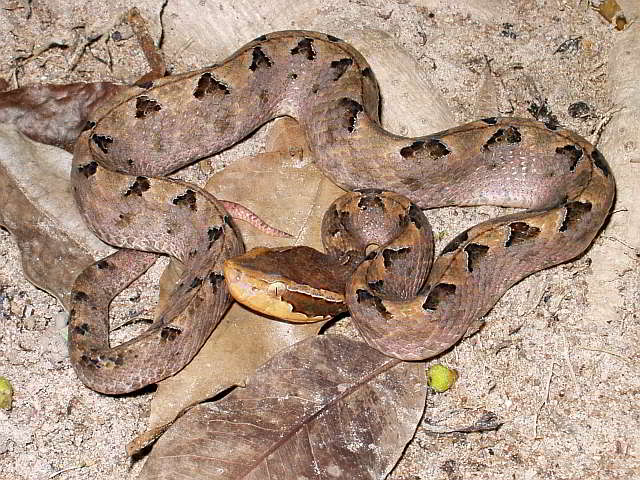Toxicity of snakes
Sources:
ELAPID SNAKES : CORAL SNAKES
- Micurus spp., Micuroides spp.
- Brightly colored rings.
- Coral snakes: black snout and consist of small yellow.
- Nonvenomous snakes: red on black.
COLUBRID SNAKES:
Several species
- Sonoran lyre snake ( Trimorphodon lambda )
- Vine snake ( Oxybelisaeneus )
- King snake ( Lampropelitsspp. )
- Fixed fangs in rear of mouth
- Must ” chew ” on victims
- Not significant cause of envenomation.
CROTAILD SNAKES ( PIT VIPERS )
- Copperheads ( Agkistrodoncontortix )
- Found in eastern United States
- Water moccasins ( AgkistrodonPiscivorus )
- Also known as the cottonmouth
- Semiaquatic, found primarily in the southeastern United States
- Small rattlesnakes
- Pygmy rattlesnakes ( Sistrurusmiliaris )
- Massasauga ( sistruruscatenatus )
- Rattlesnakes ( Crotalus )
- Found throughout the United states.
Species:
- All species susceptible
- Dogs, cats and horse commonly envenomated species.
- Usually bitten on the nose and front legs.

Fig : cobra

Fig: pit vipers
.
Fig : Coral snakes
Transmission : -By biting of poisoning snakes.
- By ingestion of contaminated food, water etc. with snake venom.
Toxic components :
- Complex mixture of amino acids, proteins, enzymes, proteins occur in snake venom.
Proteins : Large number of enzymatic and non-enzymatic proteins occur in snake venom.
a. Enzymatic proteins:
- Proteolytic enzymes ( e.g. protease )
- Hyaluronidase
- Phosphodiesterases
- ATPase
- Acetylcholinesterases
- Phospholipases A, B and c
- Lipases
- Ribonuclease
- Dexoyribonuclease
- Thrombin like enzyme
b. Non-enzymatic proteins: several low molecular weight peptides or polypeptides.
c. Non- proteins toxins:
→Lipids, steroids, glycoproteins, amines, metals ( Na, Ca, k, Mg, Zn, Ni, Fe, etc. )
Toxicity : – Varies greatly with snake
- As many as 40% of strikes are dry bites no envenomation.
Mechanism of actions:
→ Enzymes in venom break down tissues.
- Spread of venom
- Production of edema at bite site.
- Spread to surrounding tissue.
- Neurotoxicity:
a. Post synaptic neurotoxins ( elapids & sea snakes )
↓
Bind to cholinergic receptors in the neuromuscular junction
↓
Antagonize the action of Ach on skeletal muscles
↓
Paralysis ( Curare like effect )
b. Presynaptic neurotoxins ( elapids , Krait )
↓
Block release of Ach at myoneural junction
↓
Block neurotransmission.
- HAEMATOTOXICITY:
a. Coagulopathy :
- Venoms increase or decrease coagulation through acting upon
- Fibrinogen or fibrinolytic enzymes
- Plasminogen activators
- Prothrombin activators
- Phospholipase inhibitors
- Factor X, V, IX or C activators
- Induce or inhibit platelet aggregation
b. Cardiotoxicity;
increase capillary permeability
&
decrease intravascular blood volume
↓
Shock
c. Haemolysis :
- Haemorrhagins : hemolysis of RBC and decomposition of mucus membrane.
- Leucolysis : WBC destruction.
Clinical signs: –
- Tissue damage
- Hypotension and shock
- Local edema
- Possibly progressing to regional swelling.
- Dyspnea if bites is on face or nose
4. Bleeding
- From bite site
- Ecchymosis
- Discoloration of the affected area
5. Hemoglobinuria or myoglobinuria
6. Pain
7. Respiratory failure
- More common with coral snake bites.
Diagnosis:
- History of biting by snake.
- Clinical signs and symptoms
- Clinical pathology:
- Complete blood cell count
- Platelet count
- Prothrombin time, partial thromboplastin time
- Fibrin degradation products
- Creatine kinase
- Urine dipstick for myoglobin.
Treatment :
EMERGENCY THERAPY:
a. Management of airway, breathing, circulation
- If a bite wound is on nose or if there is pronounced swelling of the larynx, tracheotomy is needed.
b. Fluid therapy:
- Crystalloids
- Two intravenous lines may be needed
c. Oxygen therapy
SPECIFIC THERAPY:
a. Fluid therapy:
- Maintain adequate volume of fluids to prevent cardiovascular collapse.
- Administer lactated Ringer solution, normal saline solution, or crystalloid.
b. Diphenhyldramine
- Sedation
- Pretreatment for anaphylaxis against antivenin.
ANTIVENIN THERAPY:
a. Polyvalent crotalidae antivenin
- Rattlesnakes
- Derived from horse serum ( possible anaphylaxis )
- Intradermal test before treatment.
b. Micrurusfulvis antivenin:
- Eastern or Texas coral snake
- Not effective fir bites of sonoran or western coral snake
- Not as readily available a crotalidae antivenin
- Horse derived product-hypersensitivity possible.
- Intradermal test before treatment.
SUPPORTIVE THERAPY:
a. Severe bleeding
- Prepare for transfusion.
b. Respiratory dysfunction
- Provide oxygen
- Provide mechanical ventilation if necessary
- Monitor oxygenation
- Perform pulse oximetry
- Measure arterial blood gases
c. Bite wound;
- Clean and lightly wrap
Differential diagnosis:
Pit viper bite include trauma, insects bites or strings, animal, bites, draining abscess and penetrating wound.